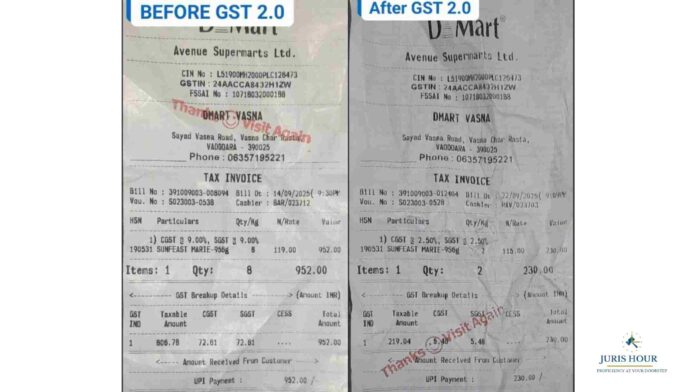A set of customer bills from retail giant DMart has sparked debate over how companies adjust their pricing strategies following changes in GST rates. While consumers expect lower taxes to reduce their shopping bills, the reality often turns out differently – with businesses quietly increasing profits.
The Case: Before vs. After GST 2.0
The two invoices, both from DMart Vasna, Vadodara, highlight how pricing has shifted after the rollout of GST 2.0:
- Before GST 2.0 (14 September 2025)
- Product: Sunfeast Marie Biscuits, 956g pack
- Quantity: 8 units
- Price per unit: ₹119
- Total: ₹952
- Tax structure: CGST @ 9% + SGST @ 9% (Total GST = 18%)
- Breakup:
- Taxable value: ₹806.78
- GST (18%): ₹145.22
- Final bill: ₹952
- After GST 2.0 (22 September 2025)
- Product: Same Sunfeast Marie Biscuits, 956g pack
- Quantity: 2 units
- Price per unit: ₹115
- Total: ₹230
- Tax structure: CGST @ 2.5% + SGST @ 2.5% (Total GST = 5%)
- Breakup:
- Taxable value: ₹219.04
- GST (5%): ₹10.96
- Final bill: ₹230
What the Numbers Reveal
At first glance, the GST cut from 18% to 5% should have meant significant savings for customers. However, a closer look shows the opposite:
- Earlier, the pre-tax price was ₹101 approx. per pack (₹806 ÷ 8).
- Now, the pre-tax price is ₹109.5 approx. per pack (₹219 ÷ 2).
In other words, the base price per pack increased by nearly 8%, even though GST was cut by 13 percentage points.
So, while the government’s intent was to pass on benefits of lower taxes to consumers, the effective retail price was only marginally reduced – and in fact, base prices went up.
Who Gains, Who Loses?
- Consumers: Expected relief but end up paying nearly the same. The benefit of tax reduction is largely neutralized by the increase in base price.
- Retailers & Manufacturers: Margins improve because the lowered tax slab creates headroom to increase pre-tax prices without shocking customers with a visibly higher final bill.
- Government: Collects less GST revenue as the rate is lower, while companies manage to keep their profitability intact.
The Broader Trend
This strategy isn’t unique to DMart. Across FMCG, retail, and consumer goods sectors, companies have historically adjusted base prices after tax reforms:
- When taxes rise, many firms absorb part of the hike to avoid scaring customers.
- When taxes fall, firms often raise base prices, capturing part of the consumer’s expected savings as profit.
Consumer Protection Angle
Experts say this practice raises questions about pass-through of tax benefits. Under anti-profiteering provisions of GST law, companies are obligated to pass on benefits of tax cuts to consumers. However, enforcement is weak and price adjustments are often disguised as “market-driven revisions.”
Consumer rights activists argue that without strict monitoring, tax cuts intended for citizens end up swelling corporate balance sheets instead.
Conclusion
The DMart receipts tell a bigger story: while GST 2.0 lowered tax rates, companies adjusted prices in a way that ensured their profits didn’t shrink. For consumers, the promised savings were minimal. For businesses, it was a textbook example of how to protect – and even grow – margins in the wake of tax reforms.
Read More: Customs at IGI Airport Seize Smuggled Gold Jewellery Worth ₹95 Lakh; Passenger Arrested

